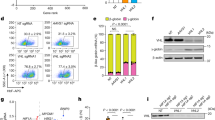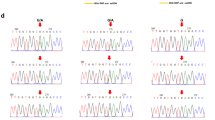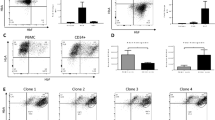Abstract
The development of red blood cells (erythrocytes) is distinguished by high-level production of the oxygen carrier, haemoglobin A (HbA), a heterotetramer of α- and β-haemoglobin subunits. HbA synthesis is coordinated to minimize the accumulation of free subunits that form cytotoxic precipitates1,2,3. Molecular chaperones that regulate globin subunit stability, folding or assembly have been proposed to exist but have never been identified. Here we identify a protein stabilizing free α-haemoglobin by using a screen for genes induced by the essential erythroid transcription factor GATA-1 (refs 4, 5). Alpha Haemoglobin Stabilizing Protein (AHSP) is an abundant, erythroid-specific protein that forms a stable complex with free α-haemoglobin but not with β-haemoglobin or haemoglobin A (α2β2). Moreover, AHSP specifically protects free α-haemoglobin from precipitation in solution and in live cells. AHSP-gene-ablated mice exhibit reticulocytosis and abnormal erythrocyte morphology with intracellular inclusion bodies that stain positively for denatured haemoglobins. Hence, AHSP is required for normal erythropoiesis, probably acting to block the deleterious effects of free α-haemoglobin precipitation. Accordingly, AHSP gene dosage is predicted to modulate pathological states of α-haemoglobin excess, such as β-thalassaemia.
This is a preview of subscription content, access via your institution
Access options
Subscribe to this journal
Receive 51 print issues and online access
$199.00 per year
only $3.90 per issue
Buy this article
- Purchase on Springer Link
- Instant access to full article PDF
Prices may be subject to local taxes which are calculated during checkout





Similar content being viewed by others
References
Baglioni, C. Chromosomal and cytoplasmic regulation of haemoglobin synthesis. Bibl. Haemat. 29, 1056–1063 (1966)
Nathan, D. G. & Gunn, R. B. Thalassemia: the consequences of unbalanced hemoglobin synthesis. Am. J. Med. 41, 815–830 (1966)
Rachmiìewitz, E. & Schrier, S. L. in Disorders of Haemoglobin (eda Steinberg, M. H., Forget, B. G., Higgs, D. R. & Nagel, R. L.) 233–251 (Cambridge Univ. Press, Cambridge, 2001)
Weiss, M. J. & Orkin, S. H. GATA transcription factors: Key regulators of hematopoiesis. Exp. Hematol. 23, 99–107 (1995)
Shirihai, O. S., Gregory, T., Yu, C., Orkin, S. H. & Weiss, M. J. ABC-me, a novel mitochondrial transporter induced by GATA-1 during erythroid differentiation. EMBO J. 19, 2492–2502 (2000)
Weiss, M. J., Keller, G. & Orkin, S. H. Novel insights into erythroid development revealed through in vitro differentiation of GATA-1- embryonic stem cells. Genes Dev. 8, 1184–1197 (1994)
Fujiwara, Y., Browne, C. P., Cunniff, K., Goff, S. C. & Orkin, S. H. Arrested development of embryonic red cell precursors in mouse embryos lacking transcription factor GATA-1. Proc. Natl Acad. Sci. USA 93, 12355–12358 (1996)
Miele, G., Manson, J. & Clinton, M. A novel erythroid-specific marker of transmissible spongiform encephalopathies. Nature Med. 7, 361–364 (2001)
Nathan, D. G., Stossel, T. B., Gunn, R. B., Zarkowsky, H. S. & Laforet, M. T. Influence of hemoglobin precipitation on erythrocyte metabolism in alpha and beta thalassemia. J. Clin. Invest. 48, 33–41 (1969)
Shinar, E., Shalev, O., Rachmilewitz, E. A. & Schrier, S. L. Erythrocyte membrane skeleton abnormalities in severe beta-thalassemia. Blood 70, 158–164 (1987)
Sorensen, S., Rubin, E., Polster, H., Mohandas, N. & Schrier, S. The role of membrane skeletal-associated alpha-globin in the pathophysiology of beta-thalassemia. Blood 75, 1333–1336 (1990)
Yuan, J. et al. The instability of the membrane skeleton in thalassemic red blood cells. Blood 86, 3945–3950 (1995)
Yuan, J. et al. Accelerated programmed cell death (apoptosis) in erythroid precursors of patients with severe beta-thalassemia (Cooley's anemia). Blood 82, 374–377 (1993)
Pootrakul, P. et al. A correlation of erythrokinetics, ineffective erythropoiesis, and erythroid precursor apoptosis in Thai patients with thalassemia. Blood 96, 2606–2612 (2000)
Centis, F. et al. The importance of erythroid expansion in determining the extent of apoptosis in erythroid precursors in patients with beta-thalassemia major. Blood 96, 3624–3629 (2000)
Rachmilewitz, E. A., Peisach, J. & Blumberg, W. E. Studies on the stability of oxyhemoglobin A and its constituent chains and their derivatives. J. Biol. Chem. 246, 3356–3366 (1971)
Wickramasinghe, S. N. & Hughes, M. Ultrastructural studies of erythropoiesis in beta-thalassaemia trait. Br. J. Haematol. 46, 401–407 (1980)
Ciavatta, D. J., Ryan, T. M., Farmer, S. C. & Townes, T. M. Mouse model of human beta zero thalassemia: targeted deletion of the mouse beta maj- and beta min-globin genes in embryonic stem cells. Proc. Natl Acad. Sci. USA 92, 9259–9263 (1995)
Yang, B. et al. A mouse model for beta (0)-thalassemia. Proc. Natl Acad. Sci. USA 92, 11608–11612 (1995)
Shaeffer, J. R. Evidence for soluble alpha-chains as intermediates in hemoglobin synthesis in the rabbit reticulocyte. Biochem. Biophys. Res. Commun. 28, 647–652 (1967)
Tavill, A. S., Grayzel, A. I., Vanderhoff, G. A. & London, I. M. The control of hemoglobin synthesis. Trans. Assoc. Am. Physic. 80, 305–313 (1967)
Prusiner, S. B., Scott, M. R., DeArmond, S. J. & Cohen, F. E. Prion protein biology. Cell 93, 337–348 (1998)
Wickner, S., Maurizi, M. R. & Gottesman, S. Posttranslational quality control: folding, refolding, and degrading proteins. Science 286, 1888–1893 (1999)
Bank, A. & O'Donnell, J. V. Intracellular loss of free α chains in β-thalassaemia. Nature 222, 295–296 (1969)
Shaeffer, J. R. Turnover of excess hemoglobin α chains in β-thalassemic cells is ATP-dependent. J. Biol. Chem. 258, 13172–13177 (1983)
Huang, S.-C. & Benz, E. J. in Disorders of Haemoglobin (eds Steinberg, M. H., Forget, B. G., Higgs, D. R. & Nagel, R. L.) 146–173 (Cambridge Univ. Press, Cambridge, 2001)
Gregory, T. et al. GATA-1 and erythropoietin cooperate to promote erythroid cell survival by regulating bcl-xL expression. Blood 94, 87–96 (1999)
Ikeda-Saito, M., Inubushi, T. & Yonetani, T. in Hemoglobins (eds Antonini, E., Rossi-Bernardi, L. & Chiancone, E.) 113–121 (Academic, New York, 1981)
Rachmilewitz, E. A. Denaturation of the normal and abnormal hemoglobin molecule. Semin. Hematol. 11, 441–462 (1974)
Acknowledgements
We thank S. Krishnaswamy for advice and assistance in biochemical studies and use of equipment, J. Yu and Z. He for technical assistance, D. Speicher for assistance with protein sequencing, C. Clendenin for assistance with mouse blastocyst injections, T. Labosky for providing embryonic stem cells, and D. Nathan, D. Pellman and W. Englander for helpful discussions and review of the manuscript. This work was funded by grants from the Cooley's Anemia Foundation (M.J.W.), the Unico Foundation (M.J.W.) and the National Institutes of Health (M.J.W., J.E.R. and G.A.B.) M.J.W. is a recipient of The American Society of Hematology Junior Faculty Award.
Author information
Authors and Affiliations
Corresponding author
Ethics declarations
Competing interests
The authors declare that they have no competing financial interests
Rights and permissions
About this article
Cite this article
Kihm, A., Kong, Y., Hong, W. et al. An abundant erythroid protein that stabilizes free α-haemoglobin. Nature 417, 758–763 (2002). https://doi.org/10.1038/nature00803
Received:
Accepted:
Issue Date:
DOI: https://doi.org/10.1038/nature00803
This article is cited by
-
Molecular Chaperones as Therapeutic Target: Hallmark of Neurodegenerative Disorders
Molecular Neurobiology (2023)
-
Age and sex effects across the blood proteome after ionizing radiation exposure can bias biomarker screening and risk assessment
Scientific Reports (2022)
-
Integrated bioinformatics analysis reveals marker genes and immune infiltration for pulmonary arterial hypertension
Scientific Reports (2022)
-
Alpha-hemoglobin-stabilizing protein (AHSP): a modulatory factor in β-thalassemia
International Journal of Hematology (2020)
-
Multiple Functions of Spectrin: Convergent Effects
The Journal of Membrane Biology (2020)
Comments
By submitting a comment you agree to abide by our Terms and Community Guidelines. If you find something abusive or that does not comply with our terms or guidelines please flag it as inappropriate.



